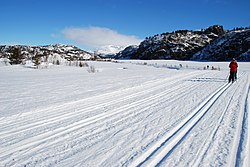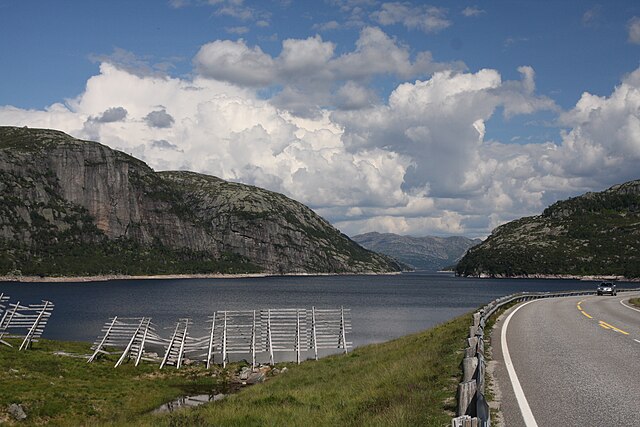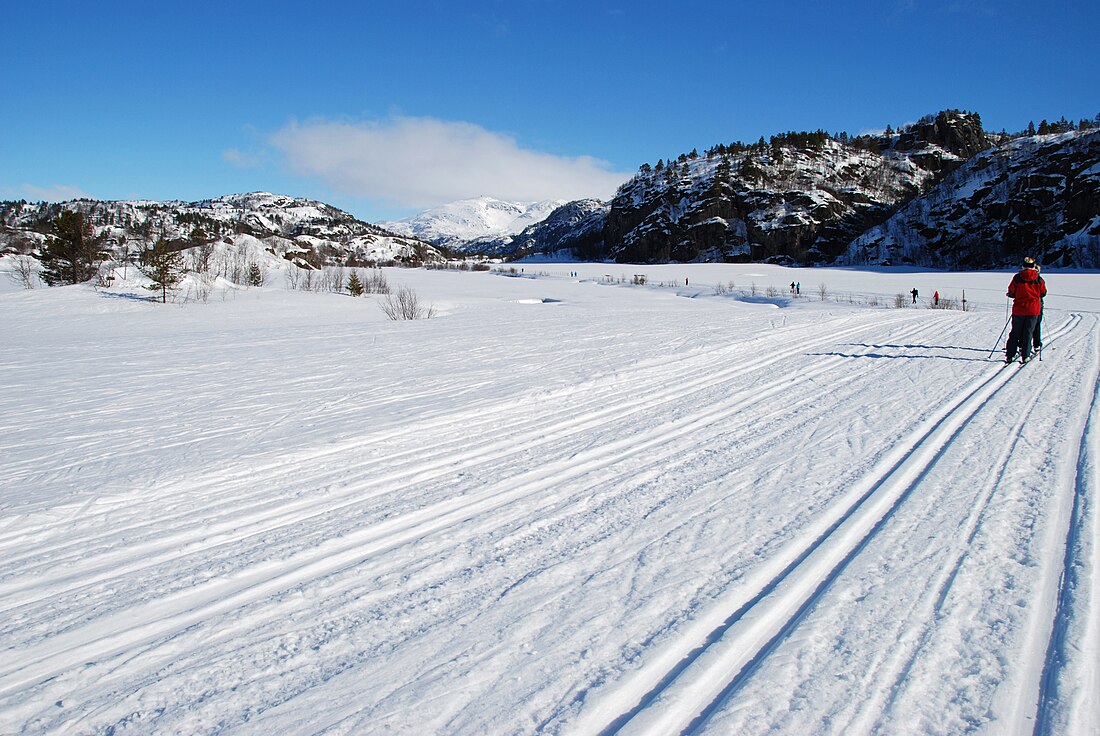Sirdal
Municipality in Agder, Norway From Wikipedia, the free encyclopedia
Sirdal is a municipality in Agder county, Norway. It is located in the northwestern part of the traditional district of Lister. The administrative centre of the municipality is the village of Tonstad. Other villages in Sirdal include Bjørnestad, Haughom, Kvæven, Lunde, and Tjørhom.
Sirdal Municipality
Sirdal kommune | |
|---|---|
 Ski-tracks in Sirdal | |
|
| |
 Agder within Norway | |
 Sirdal within Agder | |
| Coordinates: 58°51′43″N 06°48′48″E | |
| Country | Norway |
| County | Agder |
| District | Lister |
| Established | 1849 |
| • Preceded by | Bakke Municipality |
| Disestablished | 1 January 1905 |
| • Succeeded by | Tonstad and Øvre Sirdal municipalities |
| Re-established | 1 January 1960 |
| • Preceded by | Bakke, Tonstad, and Øvre Sirdal |
| Administrative centre | Tonstad |
| Government | |
| • Mayor (2019) | Jonny Liland (Ap) |
| Area | |
| • Total | 1,554.27 km2 (600.11 sq mi) |
| • Land | 1,372.87 km2 (530.07 sq mi) |
| • Water | 181.40 km2 (70.04 sq mi) 11.7% |
| • Rank | #52 in Norway |
| Population (2023) | |
| • Total | 1,837 |
| • Rank | #290 in Norway |
| • Density | 1.3/km2 (3/sq mi) |
| • Change (10 years) | |
| Demonym | Sirdøl[1] |
| Official language | |
| • Norwegian form | Neutral |
| Time zone | UTC+01:00 (CET) |
| • Summer (DST) | UTC+02:00 (CEST) |
| ISO 3166 code | NO-4228[3] |
| Website | Official website |
The 1,554-square-kilometre (600 sq mi) municipality is the 52nd largest by area out of the 356 municipalities in Norway. Sirdal is the 290th most populous municipality in Norway with a population of 1,837. The municipality's population density is 1.3 inhabitants per square kilometre (3.4/sq mi) and its population has inmcreased by 0.3% over the previous 10-year period.[4][5]
General information




The old parish of Sirdal was first established as a municipality in 1849 when it was separated from the large municipality of Bakke. Initially, Sirdal had 1,804 residents. On 1 January 1903, a small area of Sirdal (population: 63) was transferred to the neighboring municipality of Fjotland. On 1 January 1905, the municipality of Sirdal was dissolved and its territories were divided into two new municipalities: Tonstad (population: 828) and Øvre Sirdal (population: 753). These large, sparsely populated municipalities merged along with the Øksendal area of Bakke municipality to recreate the municipality of Sirdal on 1 January 1960. This time, Sirdal started out with a population of 1,426. On 1 January 1987, the Virak and Espetveit areas of northern Flekkefjord (population: 41) were transferred to Sirdal municipality.[6]
Name
The municipality (originally the parish) is named after the Sirdalen valley (Old Norse: Sírudalr) since the valley runs through the municipality. The first element is the genitive case of the river name Síra (now the Sira river). The river name has an unknown meaning, but it could be something like "strong stream". The last element is dalr which means "valley" or "dale".[7]
Coat of arms
The coat of arms was granted on 17 January 1986. The official blazon is "Vert, three ptarmigans volant argent" (Norwegian: I grønt tre oppflygande sølv ryper, 2 - 1). This means the arms have a green field (background) and the charge is a willow ptarmigan (Lagopus lagopus). The ptarmigan has a tincture of argent which means it is commonly colored white, but if it is made out of metal, then silver is used. The green color in the field and the ptarmigans were chosen as a symbol for the hills and moorland which make up the largest part of the municipality. The willow ptarmigan is a typical bird for the area. The arms were designed by Stein Davidsen. The municipal flag has the same design as the coat of arms.[8][9][10]
Churches
The Church of Norway has one parish (sokn) within the municipality of Sirdal. It is part of the Lister og Mandal prosti (deanery) in the Diocese of Agder og Telemark.
| Parish (sokn) | Church name | Location of the church | Year built |
|---|---|---|---|
| Sirdal | Haughom Chapel | Haughom | 1930 |
| Kvævemoen Chapel | Kvæven | 1962 | |
| Lunde Church | Lunde | 1873 | |
| Tonstad Church | Tonstad | 1852 |
Geography
Sirdal municipality includes the westernmost valley in Agder county, bordering Rogaland county to the west. To the south, it borders on the municipality of Flekkefjord and to the east is Kvinesdal. Sirdal is the largest municipality by area in Agder. Lakes in the region include Gravatnet, Kulivatnet, Kvifjorden, Øyarvatnet, Rosskreppfjorden, Sirdalsvatnet, and Valevatn. The mountain Urddalsknuten lies at the northern end of the municipality.
In 1990, the mountain road opened between the Sirdalen valley and the Setesdal valley over the Suleskard mountain pass. It connected Sirdal to Brokke in the neighboring municipality of Valle to the east. It shortened the distance from Oslo to Stavanger by 110 kilometres (68 mi) in the summer, and the road passes through barren, glacier-scoured highland. As it passes by the Rosskreppfjorden, it ascends to over 1,000 metres (3,300 ft) above sea level.[11]
Climate
| Climate data for Tonstad 1961-90 | |||||||||||||
|---|---|---|---|---|---|---|---|---|---|---|---|---|---|
| Month | Jan | Feb | Mar | Apr | May | Jun | Jul | Aug | Sep | Oct | Nov | Dec | Year |
| Daily mean °C (°F) | −2.0 (28.4) |
−2.2 (28.0) |
0.8 (33.4) |
4.4 (39.9) |
9.8 (49.6) |
13.4 (56.1) |
15.0 (59.0) |
14.4 (57.9) |
10.7 (51.3) |
6.9 (44.4) |
2.3 (36.1) |
−1.3 (29.7) |
6.0 (42.8) |
| Average precipitation mm (inches) | 185 (7.3) |
131 (5.2) |
139 (5.5) |
74 (2.9) |
102 (4.0) |
99 (3.9) |
109 (4.3) |
147 (5.8) |
213 (8.4) |
248 (9.8) |
239 (9.4) |
204 (8.0) |
1,890 (74.4) |
| Source: Norwegian Meteorological Institute[12] | |||||||||||||
Government
Sirdal Municipality is responsible for primary education (through 10th grade), outpatient health services, senior citizen services, welfare and other social services, zoning, economic development, and municipal roads and utilities. The municipality is governed by a municipal council of directly elected representatives. The mayor is indirectly elected by a vote of the municipal council.[13] The municipality is under the jurisdiction of the Dalane District Court and the Gulating Court of Appeal.
Municipal council
The municipal council (Kommunestyre) of Sirdal is made up of 19 representatives that are elected to four year terms. The tables below show the current and historical composition of the council by political party.
| Party name (in Norwegian) | Number of representatives | |
|---|---|---|
| Labour Party (Arbeiderpartiet) | 6 | |
| Progress Party (Fremskrittspartiet) | 1 | |
| Conservative Party (Høyre) | 3 | |
| Christian Democratic Party (Kristelig Folkeparti) | 3 | |
| Centre Party (Senterpartiet) | 5 | |
| Liberal Party (Venstre) | 1 | |
| Total number of members: | 19 | |
| Party name (in Norwegian) | Number of representatives | |
|---|---|---|
| Labour Party (Arbeiderpartiet) | 8 | |
| Conservative Party (Høyre) | 3 | |
| Christian Democratic Party (Kristelig Folkeparti) | 2 | |
| Centre Party (Senterpartiet) | 4 | |
| Liberal Party (Venstre) | 1 | |
| Joint list of the Progress Party and the Sirdal list (Fremskrittspartiet og Sirdalslisten) | 1 | |
| Total number of members: | 19 | |
| Party name (in Norwegian) | Number of representatives | |
|---|---|---|
| Labour Party (Arbeiderpartiet) | 6 | |
| Conservative Party (Høyre) | 3 | |
| Christian Democratic Party (Kristelig Folkeparti) | 3 | |
| Centre Party (Senterpartiet) | 4 | |
| Liberal Party (Venstre) | 1 | |
| Sirdal local list (Sirdal Bygdeliste) | 2 | |
| Total number of members: | 19 | |
| Party name (in Norwegian) | Number of representatives | |
|---|---|---|
| Labour Party (Arbeiderpartiet) | 5 | |
| Progress Party (Fremskrittspartiet) | 2 | |
| Conservative Party (Høyre) | 2 | |
| Christian Democratic Party (Kristelig Folkeparti) | 3 | |
| Centre Party (Senterpartiet) | 3 | |
| Liberal Party (Venstre) | 1 | |
| Rural development list (Bygdeutviklingslista) | 3 | |
| Total number of members: | 19 | |
| Party name (in Norwegian) | Number of representatives | |
|---|---|---|
| Labour Party (Arbeiderpartiet) | 3 | |
| Progress Party (Fremskrittspartiet) | 3 | |
| Conservative Party (Høyre) | 2 | |
| Christian Democratic Party (Kristelig Folkeparti) | 4 | |
| Centre Party (Senterpartiet) | 5 | |
| Socialist Left Party (Sosialistisk Venstreparti) | 1 | |
| Liberal Party (Venstre) | 1 | |
| Total number of members: | 19 | |
| Party name (in Norwegian) | Number of representatives | |
|---|---|---|
| Labour Party (Arbeiderpartiet) | 3 | |
| Progress Party (Fremskrittspartiet) | 3 | |
| Conservative Party (Høyre) | 3 | |
| Christian Democratic Party (Kristelig Folkeparti) | 3 | |
| Centre Party (Senterpartiet) | 4 | |
| Socialist Left Party (Sosialistisk Venstreparti) | 2 | |
| Liberal Party (Venstre) | 1 | |
| Total number of members: | 19 | |
| Party name (in Norwegian) | Number of representatives | |
|---|---|---|
| Labour Party (Arbeiderpartiet) | 4 | |
| Progress Party (Fremskrittspartiet) | 1 | |
| Conservative Party (Høyre) | 4 | |
| Christian Democratic Party (Kristelig Folkeparti) | 3 | |
| Centre Party (Senterpartiet) | 5 | |
| Liberal Party (Venstre) | 2 | |
| Total number of members: | 19 | |
| Party name (in Norwegian) | Number of representatives | |
|---|---|---|
| Labour Party (Arbeiderpartiet) | 4 | |
| Conservative Party (Høyre) | 3 | |
| Christian Democratic Party (Kristelig Folkeparti) | 3 | |
| Centre Party (Senterpartiet) | 5 | |
| Liberal Party (Venstre) | 4 | |
| Total number of members: | 19 | |
| Party name (in Norwegian) | Number of representatives | |
|---|---|---|
| Labour Party (Arbeiderpartiet) | 4 | |
| Conservative Party (Høyre) | 3 | |
| Christian Democratic Party (Kristelig Folkeparti) | 3 | |
| Centre Party (Senterpartiet) | 6 | |
| Liberal Party (Venstre) | 3 | |
| Total number of members: | 19 | |
| Party name (in Norwegian) | Number of representatives | |
|---|---|---|
| Labour Party (Arbeiderpartiet) | 4 | |
| Conservative Party (Høyre) | 4 | |
| Christian Democratic Party (Kristelig Folkeparti) | 3 | |
| Centre Party (Senterpartiet) | 4 | |
| Liberal Party (Venstre) | 4 | |
| Total number of members: | 19 | |
| Party name (in Norwegian) | Number of representatives | |
|---|---|---|
| Labour Party (Arbeiderpartiet) | 4 | |
| Conservative Party (Høyre) | 3 | |
| Christian Democratic Party (Kristelig Folkeparti) | 3 | |
| Centre Party (Senterpartiet) | 5 | |
| Liberal Party (Venstre) | 3 | |
| Sirdal local list (Sirdal Bygdeliste) | 1 | |
| Total number of members: | 19 | |
| Party name (in Norwegian) | Number of representatives | |
|---|---|---|
| Labour Party (Arbeiderpartiet) | 3 | |
| Conservative Party (Høyre) | 4 | |
| Christian Democratic Party (Kristelig Folkeparti) | 4 | |
| Centre Party (Senterpartiet) | 5 | |
| Liberal Party (Venstre) | 1 | |
| Sirdal local list (Sirdal bygdeliste) | 2 | |
| Total number of members: | 19 | |
| Party name (in Norwegian) | Number of representatives | |
|---|---|---|
| Labour Party (Arbeiderpartiet) | 3 | |
| Conservative Party (Høyre) | 1 | |
| Centre Party (Senterpartiet) | 7 | |
| Liberal Party (Venstre) | 2 | |
| Joint list of the Christian Democratic Party (Kristelig Folkeparti) and New People's Party (Nye Folkepartiet) | 3 | |
| Sirdal local list (Sirdal Bygdeliste) | 3 | |
| Total number of members: | 19 | |
| Party name (in Norwegian) | Number of representatives | |
|---|---|---|
| Labour Party (Arbeiderpartiet) | 3 | |
| Christian Democratic Party (Kristelig Folkeparti) | 2 | |
| Centre Party (Senterpartiet) | 7 | |
| Liberal Party (Venstre) | 3 | |
| Local List(s) (Lokale lister) | 4 | |
| Total number of members: | 19 | |
| Party name (in Norwegian) | Number of representatives | |
|---|---|---|
| Labour Party (Arbeiderpartiet) | 5 | |
| Christian Democratic Party (Kristelig Folkeparti) | 1 | |
| Centre Party (Senterpartiet) | 7 | |
| Liberal Party (Venstre) | 3 | |
| List of workers, fishermen, and small farmholders (Arbeidere, fiskere, småbrukere liste) | 1 | |
| Local List(s) (Lokale lister) | 2 | |
| Total number of members: | 19 | |
| Party name (in Norwegian) | Number of representatives | |
|---|---|---|
| Labour Party (Arbeiderpartiet) | 3 | |
| Communist Party (Kommunistiske Parti) | 2 | |
| Centre Party (Senterpartiet) | 8 | |
| Liberal Party (Venstre) | 4 | |
| Local List(s) (Lokale lister) | 2 | |
| Total number of members: | 19 | |
| Party name (in Norwegian) | Number of representatives | |
|---|---|---|
| Labour Party (Arbeiderpartiet) | 2 | |
| Christian Democratic Party (Kristelig Folkeparti) | 3 | |
| Socialist People's Party (Sosialistisk Folkeparti) | 4 | |
| Joint List(s) of Non-Socialist Parties (Borgerlige Felleslister) | 10 | |
| Total number of members: | 19 | |
Mayors
The mayors (Norwegian: ordfører) of Sirdal (incomplete list):
- 1893-1894: Bernt Andreas Lindeland
- 1897-1898: Bernt Andreas Lindeland
- (1905-1959: Municipality dissolved)
- 1960-1963: Erik Kvæven
- 1964-1995: Sven Tjørhom
- 1995-2003: Torjus Kvæven (Sp)
- 2003-2011: Thor Jørgen Tjørhom (Sp)
- 2011-2015: Jonny Liland (Ap)
- 2015-2019: Thor Jørgen Tjørhom (Sp)
- 2019-present: Jonny Liland (Ap)
Economy


The main source of income for Sirdal is the Sira-Kvina Power Company which gets its power from the big Sira and Kvina rivers. The waterfalls on the river Sira are utilized in four power stations owned by Sira-Kvina power company. The company also owns three power stations in the Kvina river system, hence the company's name. Total annual production is 6,000 gigawatt-hours (22,000 TJ), total installation is 1,760 megawatts (2,360,000 hp). The largest power station, Tonstad Hydroelectric Power Station, was inaugurated in 1968, with two units, each producing 160 megawatts (210,000 hp). The power station has now 4 units, each 160 MW, and one unit at 320 megawatts (430,000 hp), giving a total output of 960 megawatts (1,290,000 hp). Total annual production in this station is approximately 4,000 gigawatt-hours (14,000 TJ), which makes Tonstad the largest power station in Norway in terms of production. Sira-Kvina power company applied in 2007 for concession to expand the power station with two new units (reversible turbines), each containing 480 megawatts (640,000 hp), and the concession is pending.[28]
Tourism is also an important source of income for the Sirdal economy, taking advantage of the extensive mountains, mountainous plateaus, lakes, and great views. There are multiple alpine resorts and hotels in the valley, as well as cottages and camping spots. Winter activities include six ski resorts for winter enjoyment. Downhill ski areas include Tjørhomfjellet, Bjørnestad Ski Centre, Ålsheia Ski Centre, Fidjeland Ski Centre, and Ådneram Ski lift. Cross-country skiers can enjoy dozens of trails over spectacular terrain. Summer activities include hiking, horseback riding, and river rafting.[28]
History
From the oldest times the Sirdalen valley was divided by the river Sira with Rogaland county controlling the west side and Agder county controlling the east side. The two sides of the valley, however, was established as one single parish in Christian times, even though it crossed county lines, something that was not very common in Norway.
In 1837, it was decided that every parish should be a municipality, but no municipality should belong to more than one county (see formannskapsdistrikt law). Sirdal parish was therefore first divided in two municipalities. This was a bad decision because they had very few inhabitants separately. A new solution was found in 1839 when the two municipalities were re-joined, and the county border was moved so that all of Sirdalen was in Vest-Agder county.
At Kvæven, in northern Sirdal one finds the Sirdal Mountain Museum. This museum has a collection of old Sirdal buildings. Former lifestyles are visible in the farmhouse, a schoolhouse, stable, blacksmith's shop, barn, and mountain farm cottage as well as original equipment.
Notable people
- Berit Kvæven (born 1942 in Øvre Sirdal), a sivilingeniør and politician
- Gunnar Tjomlid (born 1974), a skeptic, secular humanist, blogger, and author who was brought up in Sirdal
- Linda Grubben (born 1979), a World Cup biathlete
- Arild Haugen (born 1985 in Sirdal), a boxer and former strongman
International relations
Twin towns — Sister cities
 Väike-Maarja Parish, Estonia (since 1994)[29]
Väike-Maarja Parish, Estonia (since 1994)[29]
References
External links
Wikiwand in your browser!
Seamless Wikipedia browsing. On steroids.
Every time you click a link to Wikipedia, Wiktionary or Wikiquote in your browser's search results, it will show the modern Wikiwand interface.
Wikiwand extension is a five stars, simple, with minimum permission required to keep your browsing private, safe and transparent.


